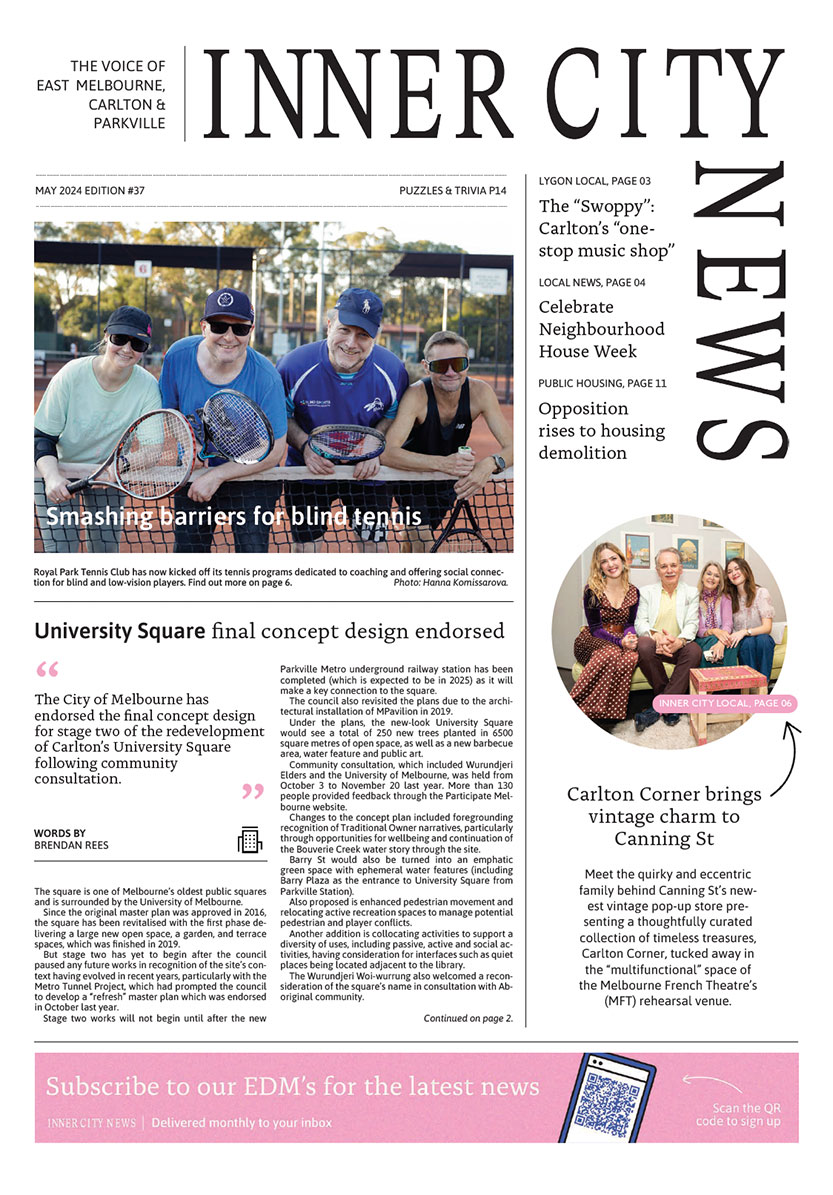Disability advocates slam inaction on accessible tram stops along Sydney Rd and Royal Parade
Advocates say continual delays to improving tram stops will result in keeping a marginalised community “invisible”.
Locals with restricted mobility face the prospect of having limited northbound public transport options from 2025 unless accessible tram stops are urgently installed on Royal Parade, Lygon St and Sydney Rd.
Those living in the neighbouring communities of Carlton and Parkville looking to travel north in a wheelchair will be severely hampered when the Victorian Government closes the Upfield train line for an expected 18 months to build Skyrail, with works expected to begin in 2025-26.
The only accessible tram stops on the popular Sydney Rd tram route, once you have left the CBD, are at Brunswick Rd and at the end of the tram line.
A 5.5km stretch (between Brunswick Rd and Bakers Rd in Coburg North) contains no accessible stops, leaving the Upfield trains as the only viable options.
For those living along Royal Parade or the northern end of Lygon St, there are currently no accessible tram stops to speak of, with the closest being the Haymarket roundabout and Elgin St in Carlton, respectively.
However, the government will soon add a new “super stop” between the Royal Melbourne Hospital and Melbourne University to connect the new underground Parkville Station when the Metro Tunnel opens in 2025.
Without access to the trains, people who use wheelchairs, have limited mobility or push prams will be significantly hindered until the Skyrail is completed, according to the government, in 2027.
While the area north of the CBD continues to be a major concern, Disability Resources Centre projects manager Ally Scott said Sydney Rd was the “big issue” they were currently focused on.
A parliamentary petition currently has almost 1000 signatures, and in June a rally was held on the tracks just north of Royal Park.
“[The trains] are the only accessible transport for locals at the moment,” Ms Scott told Inner City News.
“So, during the periods of that work there will be no form of transport, at all. So, we’re really pushing hard to get accessible stops built before the Skyrail work begins.”
Ms Scott said the issue on Sydney Rd was emblematic of a wider problem whereby the government had fallen way behind deadlines for delivering accessible tram stops.
Most tram trips in Melbourne remain inaccessible for those with restricted mobility, with just three in 10 stops in the city deemed “accessible”.
A requirement for public transport in all states and territories to be fully accessible by the end of 2022 has already been missed, and according to a 2020 Auditor General report it could take until 2066 to upgrade the entire Victorian network.
“Most of the community working on this now will not live to see that date,” she said, adding that works to improve the tram network had ground to a halt.
“It’s currently not improving at all. Right now, there’s been a complete stop on all upgrade works as we’re aware.”
The Department of Transport’s 2021-22 Annual Report revealed that just two Victorian tram stops were upgraded to include level-access.
The Andrews government planned to build six new accessible tram stops in 2022-23 – all of which on a CBD stretch of La Trobe St – however these were not delivered, nor mentioned in the 2023-24 budget released in May.
The government confirmed with Inner City News that planning and design work was under way for the six stops.
“It’s our priority to make sure our public transport network is accessible, and we are delivering projects that are making a real difference across the state,” a spokesperson said.
However, Ms Scott argued the rate at which both stops and trams themselves were being upgraded meant this was simply not true.
“Accessibility is about having low-floor trams meeting level-access stops, so it’s also about upgrading the rolling stock. Although we were promised in the (2021-22) budget 100 low-floor trams, they’re actually being delivered at the same rate as prior to that commitment … it’s not an escalation of that work at all, it doesn’t represent a greater commitment to introducing more low-floor trams. So, really there’s no prioritising of it at all.”
Advocates say public transport accessibility is not simply an issue for those with a wheelchair, but includes the older population, people using prams and those with energy management conditions.
“There’s a huge community that need that kind of service that works for everyone. So, it’s very frustrating that the government is committing a huge sum to the Big Build project, none of which covers maintaining the existing public transport,” Ms Scott said.
Residents in a wheelchair have previously told Inner City News that, even when arriving at an “accessible” stop, it was not uncommon to wait for more than 10 trams to pass until an low-floor vehicle arrived, turning what would be a short trip for most into an arduous journey.
“What that means is that people don’t use public transport. You’re not going to use public transport if you have to wait for an hour. You’re not going to use public transport if you feel unsafe. It just means that people aren’t getting out. There’s a real problem that this community are just invisible.”
Ms Scott said this further marginalised a community that in most cases required the low-cost transport option available to everyone else.
“There’s a huge intersection between disability and poverty. Very often these are people who can’t afford to run cars, they’re not people who can afford to get wheelchair-accessible cabs. They’re really dependent on public transport. It’s an extraordinary oversight by the current government.”

Carlton Corner brings vintage charm to Canning St



 Download the Latest Edition
Download the Latest Edition